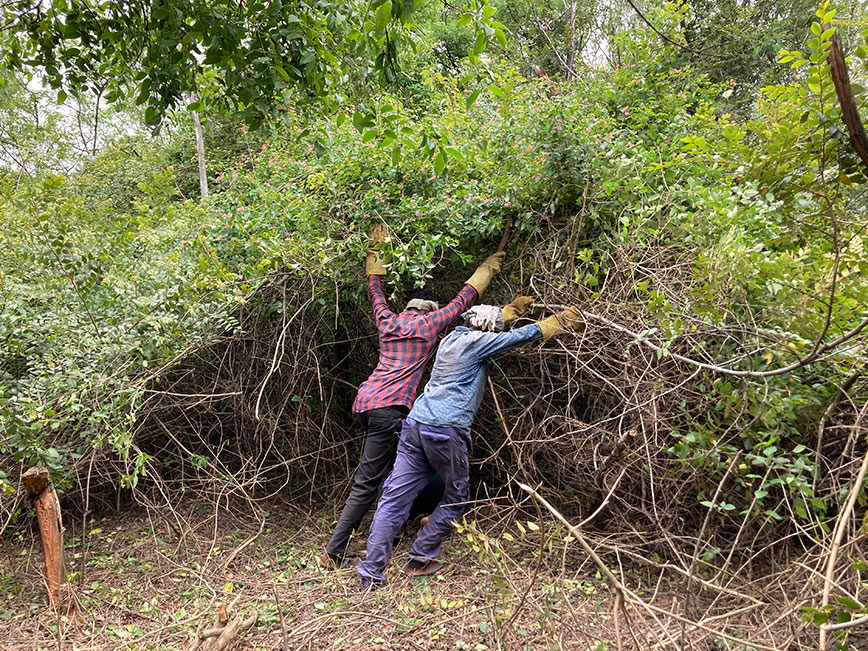The bustling city of Hyderabad, famous among youth for its "city-chills" offered at the "town-like cost of living," juxtaposed by the Quiet luxury of the old school vibes and heritage origins, packages a dynamic metropolis. However, a complex challenge lies beneath the "Hyderabadi vibes" facade - integrating professional migrants and their families, particularly the older generations who often feel isolated and marginalized. We bring the case study of the ostracised elderlies and naturalized spaces created at the Moulali Railway Colony. In March 2023, we collaborated with land authorities to reclaim this abandoned land and restore its purpose through native vegetation. This initiative changed the perception of "equitable land use".

It brought about two significant impacts on the community, which has become the epicentre of a transformation that's come to be known as "The 6-Month Miracle." Cross-Generational Social Inclusion One of the most heartening outcomes of this project is creating a cross-generational space that fosters social inclusion. Older community members, who often felt left out as their younger family immersed themselves in the offerings of the urban jungle, now have a recreational ecosystem that caters to their needs. Green spaces have the unique ability to provide a platform for interaction that transcends age barriers. This newfound oasis isn't just accessible to all age groups; it's also of interest to them, making it a natural gathering spot where stories are shared and relationships are nurtured. 2. Increasing Eco-Sensitivity The impact of this project isn't limited to social inclusion alone. By planting 8,200 saplings on this once-neglected land, the community participation in maintaining the "visible green" draws attention to shared responsibility and individual accountability. Nurturing these plants has become a collective effort, encouraging the community to own the space. In the long term, it has the potential to become a breeding ground for altruistic co-existence as individuals come together to protect and preserve their shared oasis.
"What was once a breeding ground for petty crimes and socially unaccepted activities has become a thriving green oasis." Rashmi, Resident Railway Colony "The 6-Month Miracle" at the Moulali Railway Colony Plantation site is a testament to the power of community engagement and environmental stewardship. It has transformed an abandoned space into a thriving hub of social interaction and eco-sensitivity. In an urban landscape that often neglects its older generations, this initiative is a profound example of how a plantation drive can bring about meaningful change. It proves that with determination and a shared vision, we can create spaces that benefit everyone in the community, fostering unity and sustainability.
Nearly 200 years ago, an ornamental plant made its way to India from South America, thanks to the British. Each flower of this plant seems like a cluster of small, vibrantly coloured flowers, its centre a flaming orange that bleeds into a warm yellow as it spreads towards its flowers, which are frequently pink. Each tiny flower carries several seeds in them. The Lantana Camara is a common sight and a rather pleasant one. But for all of its beauty, the plant is also one of the most invasive species known to man.
SayTrees is working on a pilot project that aims to restore the landscape of a 45-acre forest on the outskirts of Bengaluru. When we began the project, one of the first and most obvious problems was Lantana. The forest was covered with this non-native, invasive species. Right from shrubs to thick bushes, Lantana plants of all sizes had engulfed swathes of the forest to a point where one couldn’t see what the forest looked like beyond the Lantana.
So we began to clear the path.

Now, the topic of Lantana removal is admittedly a contentious one. Several people working in the space of conservation and restoration believe that the primary problem with the overgrowth of Lantana is how it hinders the growth of native species within the landscape. Lantana competes for resources with other, native species in the region and its growth across large areas suffocates the native species growing near the ground and prevents them from blossoming. Since the plant and other invasive species cover so much of the forest, there have been several instances where wild animals like elephants have been unable to enter the forests, resulting in an increase in man-animal conflict. This has been seen in Mudumalai, Bandipur and Nagarhole among other places. Given this history of Lantana, it seems only natural that the solution is to remove it all. But some disagree.
Individuals working in the restoration space have also seen some benefits of Lantana. In spaces where there is an abundance of the species, there has also been an increase in the number of birds, insects and small animals. Moreover, removing Lantana is not a one-time job. The entire process is strenuous, takes a lot of time and requires constant maintenance to ensure that the Lantana doesn’t grow back nor is it replaced by other invasive species. While people on the same side of the debate try to figure out what the optimal solution would be, the fact remains that we have very little to no data on what the long terms benefits of removing or not removing Lantana are.
After weighing the pros and cons of the situation, we have decided on pursuing a scientific approach to remove lantana where we cut down the bushes and uproot the plant and process it through a shredder. The product of this process in our case is ‘biomass’, which can be used for mulching and composting through our restoration journey ahead.
What after all the Lantana is cleared? More on that in our next blog post!